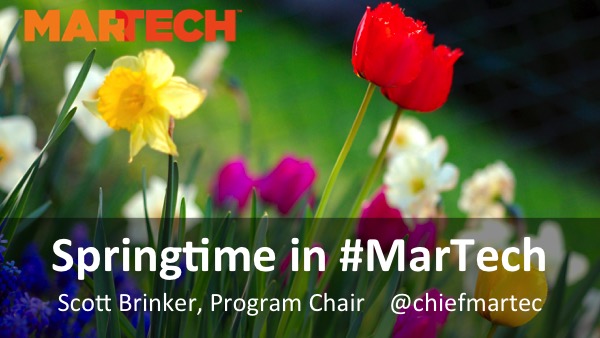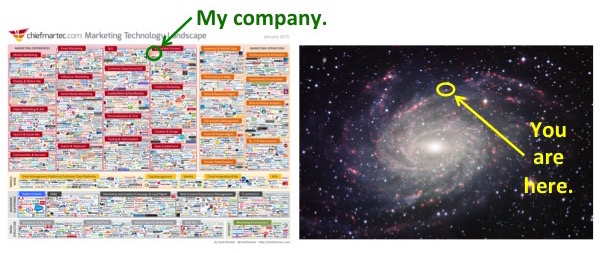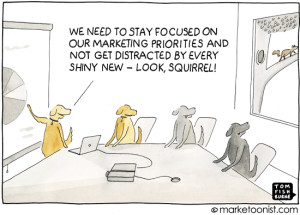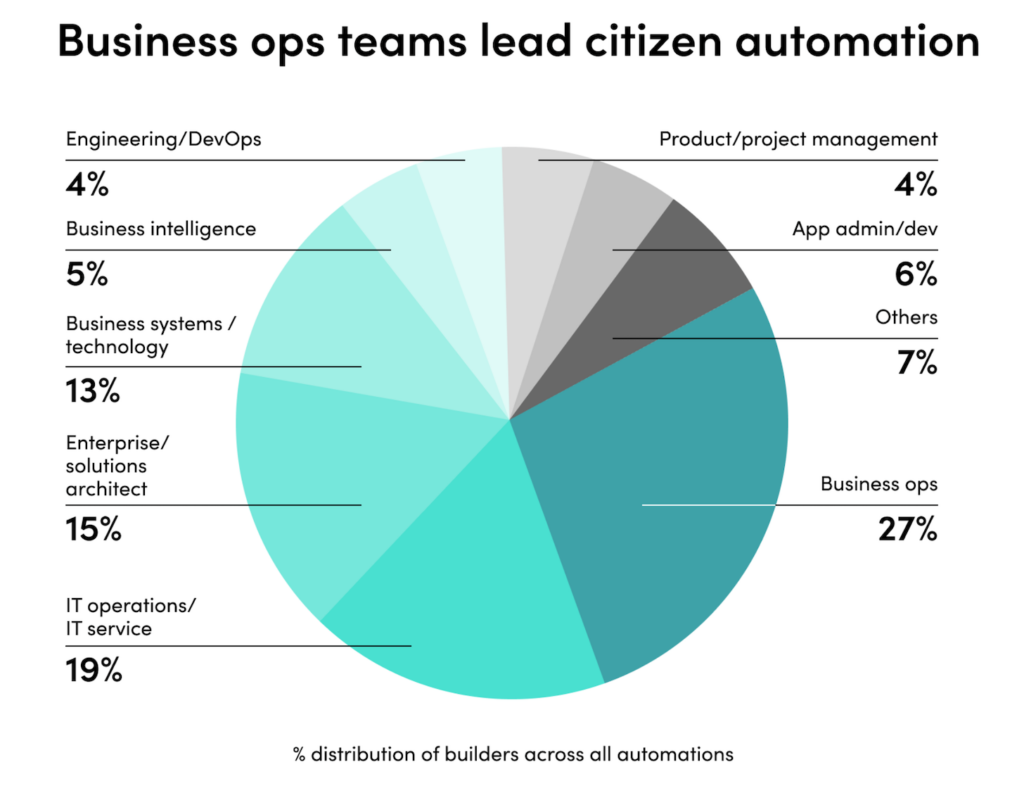The following is an approximation of my opening presentation at the MarTech Conference this morning in San Francisco. Over 1,000 people are there, participating in the largest independent conference exclusively focused on marketing technology and marketing technologists.
I am so happy that spring is here.
It was a pretty crazy winter in Boston this year. This is a picture of the six-foot mountain of ice that I shoveled through on my sidewalk. Before I had to commute with my sled dogs to work. Uphill, both ways.
Seriously, by the fifth or sixth blizzard in a month, people pretty much lost their minds, and started diving out their windows into snowbanks in their underwear. Those are the moments that Meerkat and Periscope were clearly invented to capture.
So for the past three months, I’ve been dreaming about MarTech. In spring. In California. With a big smile.
By the way, we’ll be back in San Francisco next spring, March 21-22, 2016 — save the dates. I’m also very excited to announce that we will be launching MarTech Europe this fall in London, October 20-21. Because martech is truly a global phenomenon.
But let’s celebrate spring for a moment. Glorious, wonderful spring. Everything blossoms. Days get longer. Temperatures heat up. Predators emerge from hibernation.
Actually, that is the perfect metaphor for the state of marketing technology today, isn’t it? It’s springtime in martech. And nowhere do we see more blossoming than in the marketing technology landscape. The breadth and diversity of marketing technology innovation that’s represented there is staggering. It literally makes you stagger.
Collectively, the reaction from most marketers — and marketing technology companies — could be best characterized by Edvard Munch’s The Scream. Or that kid from Home Alone, when he slaps aftershave on his face for the first time.
“Gaaaaaaaaahhhhhhhhhhh!!!!!”
You know, I didn’t set out with a mission to scare the bejesus out of marketers. When I first started charting marketing technologies in 2011, my intent was simply to demonstrate that marketing was becoming a technology-powered discipline. Even back then, many marketers had what would qualify as a robust “marketing stack” — a collection of many different tools across their digital marketing environment.
It was when I kept revising the graphic, year after year, and it tripled in size, and then tripled again, and then doubled yet again, that the narrative changed. The point that marketing was a now tech-powered discipline was a little conceptual thumbtack — that had been slammed into the wall with a Thor-like sledgehammer. The narrative became, “Oh, my god, have you see that massive, terrifying mega-hammer!”
So, um, I apologize for that. Send me a bill for the damage to the wall. Or hang a poster there.
But this landscape-as-the-narrative is fascinating in its own right. In a recent study conducted by Signal with marketers, 2/3 of them said they feel the marketing technology landscape is evolving rapidly — or even faster. “Evolving at light speed,” 6% of them said. There’s emotion in that statement. We feel this tremendous change in a quite visceral way, like wading waist-deep into a stream with a swift current.
Although I do wonder about the 3% of the respondents who answered “not much” to that question. Do they still fog the mirror? Or are they just really, really jaded? An image of Statler and Waldorf, the cranky, old dudes from The Muppets, comes to mind.
But while this landscape has a narrative of its own, it’s important to remember that the real narrative is the transformation of marketing — and business, and life — that is underway in a fully connected, digital world. This landscape is merely a shadow cast from that much bigger metamorphosis. It’s sometimes hard to quantify that larger remaking of marketing. But this landscape is one concrete artifact of its scale.
That grand metamorphosis is the real challenge for marketers.
By the way, if you want a doubly-difficult challenge, try being a marketer at one of these marketing technology companies. We’re not just discovering the new dynamics of marketing, on-the-job, like the rest of you. We’re also each trying to carve out our place in this immense universe.
For example, here’s my company — in a crowded, but exciting category of interactive content. That would be challenging enough. But then you pan out to the entire landscape, and suddenly you need a navigational aid. It’s like one of those planetarium exhibitions where they show you where you are relative to the cosmos. It can be a little humbling.
I tried to capture the system dynamics of this landscape — to attempt to explain why it’s grown so large and has continued to grow, despite all the calls for consolidation. If you want some light reading at any point, just Google “system dynamics of marketing technology” to find that post.
I think that was the post that made my friends and family genuinely worry about me. They were concerned that I was having some sort of episode, like John Nash in A Beautiful Mind, when he starts drawing imaginary connections between spy networks in newspaper clippings.
I do want to highlight one set of forces in those dynamics — marketing technology as a financially attractive market. Because the finances here help quantify the scale. Gerry Murray of IDC, who will be speaking later this afternoon, estimated that the worldwide market for marketing software was over $20 billion last year — and will grow to more than $32 billion in 2018.
Ashu Garg, general partner at Foundation Capital, a leading venture capital firm active in the martech space, has predicted that spend on marketing technology will grow 10x in 10 years — and will come to represent 10% of the total spend in marketing. Ashu will be joining us for tomorrow’s closing fireside chat, so we’ll get to ask him more about that directly.
And the latest investment data from VB Profiles, which I just got last weekend, shows that over $25 billion has been invested in marketing technology companies to date — and that doesn’t include IPOs or acquisitions. That’s up about $3.5 billion since the data they gave me last fall on the smaller 2014 landscape:
A few remarkable data points that they unearthed in their research:
- There are 26 martech “unicorns” — companies valued in excess of $1 billion.
- There’s been $2.41 of materialized ROI on these martech investments to date.
- These martech companies collectively employ over 300,000 people.
Keep in mind, that doesn’t include anything from the Infrastructure or Internet categories on the landscape, which are obviously bigger than their role in the marketing department. If you add those back in, they represent additional investment of $4.6 billion and $16 billion, respectively — which would bring the total up to $45.8 billion.
It is true that there is consolidation in the martech ecosystem. Companies are being acquired, and others are being shuttered. But so far, the pace of innovation — new companies being created — continues to outpace the rate of ventures exiting the sector.
And the truth is, even though there are grumbles of tool exhaustion, marketers are assimilating more of these technologies into their operations. A recent study by Econsultancy and Tealium found that 51% of marketers surveyed had 21 or more marketing technology vendors that they worked with. Three years ago, only 36% of them had that many.
I know, we laugh at how crazy this seems. I love this cartoon by Tom Fishburne: “We need to stay focused on our marketing priorities and not get distracted by every shiny new — look, squirrel!”
And the phrase “frankenstack” has entered our industry’s lingo, as a way of describing a marketing technology stack that is made up of a shambling mishmash of martech parts. It’s aaaaaaalive!
But if you actually look at the real marketing stack of a company that has thought about what they’re doing, you’ll find that, yes, there are a lot of products in the mix — but they make sense together. Each has its purpose, and the way they interconnect is quite rational. Here’s a terrific example of Five9’s marketing stack:
If it’s a frankenstack, it’s a lovable one. Like Peter Boyle in Young Frankenstein.
As I talk with more and more marketers who are comfortable with the heterogeneous set of technologies that they’ve thoughtfully assembled for their business, I’ve decided that architecture and strategy are the difference between a marketing stack and a marketing pile.
If you establish clarity about what you’re trying to achieve, and if you have good marketing technologist talent helping to connect the dots, that gigantor marketing technology landscape becomes less of a boogeyman and more of a source of strength.
The purpose of this conference is to help you build that strength, by sharing the experiences of practitioners and the insights of true martech experts — but most importantly, by connecting you with your peers at the intersection of marketing and technology.
As we go through the next two days together, there’s a quote I’d like you to keep in mind from my friend Ann Handley, chief content officer of MarketingProfs and one of the world’s leading authorities on content marketing. She said:
Technology is only as good as the story.
– Ann Handley
Ann’s not against technology, by any stretch of the imagination. But her point is that unless marketing technology is applied in the service of a great story — a compelling story, crafted lovingly for prospects and customers — it’s just algorithmic sound and fury, signifying nothing.
I couldn’t agree more. However, I’d add one important corollary:
In a digital world,
programming is storytelling too.
In the movies, you tell a story with a set, lighting, costumes, cameras, sound equipment, editing tools, effects. In digital marketing — and in a digital world, all marketing is digital in some way — you tell a story with software and data. Your choice of software and your proficiency in wielding it materially affect the stories you can tell.
Digital storytelling is rendered through:
- Software bought and built
- Configurations and parameters of that software
- Algorithms and processes design
- User experience (UX) design
- Data processing and flow
Software functionality and flow are woven into the narrative of your buyer’s journey. So while it’s fair to say that your software is useless if you don’t have a great story to tell with it, it’s also critical to recognize that without the right software capabilities, your story may be diminished in digital darkness. It would be like writing the perfect script for a blockbuster movie, yet having no way to produce it.
To end with one last movie metaphor, marketing is living out The Secret Life of Walter Mitty. We’ve been in the business of imagining great narratives — and using communications to get our buyers to picture those narratives in their heads. But in a digital world, where it’s not just about what we say, but more about what we do. It’s about getting our prospects to experience our narratives. Software is the conduit through which those narratives are brought to life.
If you weren’t able to attend MarTech this time, but you find that any of the above resonates, please do join us in London for MarTech Europe, October 20-21, 2015 or in San Francisco next March 21-22, 2016.














Great article. The technology field has really become complicated. But for a savy marketer who knows how to navigate between all the shiny new objects…there are so many more tools that can get you to your niche market.
I really am a novice marketer. I have so much to learn. Thanks for the reminder about the need to tech a story in your marketing, and not relying on technology to do the job for you.